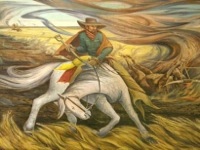Difference between revisions of "Mural"
(Created page with 'File:lighterstill.jpgright|frame ==Origin== Latin ''muralis'', from ''murus'' wall *[http://en.wikipedia.org/...') |
m (Text replacement - "http://" to "https://") |
||
| Line 3: | Line 3: | ||
==Origin== | ==Origin== | ||
[[Latin]] ''muralis'', from ''murus'' wall | [[Latin]] ''muralis'', from ''murus'' wall | ||
| − | *[ | + | *[https://en.wikipedia.org/wiki/16th_century 1586] |
==Definitions== | ==Definitions== | ||
*1: of, relating to, or resembling a wall | *1: of, relating to, or resembling a wall | ||
| Line 10: | Line 10: | ||
A '''mural''' is any piece of artwork painted or applied directly on a wall, ceiling or other large permanent surface. A particularly distinguishing characteristic of mural [[painting]] is that the architectural elements of the given [[space]] are harmoniously incorporated into the [[picture]]. | A '''mural''' is any piece of artwork painted or applied directly on a wall, ceiling or other large permanent surface. A particularly distinguishing characteristic of mural [[painting]] is that the architectural elements of the given [[space]] are harmoniously incorporated into the [[picture]]. | ||
| − | Some wall paintings are painted on large canvases, which are then attached to the wall (e.g., with [ | + | Some wall paintings are painted on large canvases, which are then attached to the wall (e.g., with [https://en.wikipedia.org/wiki/Marouflage marouflage]). Whether these works can be accurately called "murals" is a subject of some [[controversy]] in the art world, but the [[technique]] has been in common use since the late 19th century. |
| − | Murals of sorts date to [ | + | Murals of sorts date to [https://en.wikipedia.org/wiki/Upper_Paleolithic Upper Paleolithic] times such as the paintings in the [https://en.wikipedia.org/wiki/Chauvet_Cave Chauvet Cave] in Ardèche department of southern France (around 30,000 BC). Many [[ancient]] murals have survived in Egyptian [[tombs]] (around 3150 BC), the [https://en.wikipedia.org/wiki/Minoan_civilization Minoan palaces] (Middle period III of the Neopalatial period, 1700-1600 BC) and in [https://en.wikipedia.org/wiki/Pompeii Pompeii] (around 100 BC - AD 79). |
| − | In [[modern]] times, the term became more well-known with the Mexican "muralista" art movement ([ | + | In [[modern]] times, the term became more well-known with the Mexican "muralista" art movement ([https://en.wikipedia.org/wiki/Diego_Rivera Diego Rivera], David Siqueiros, or José Orozco). There are many different styles and techniques. The best-known is probably [https://en.wikipedia.org/wiki/Fresco ''fresco''], which uses water-soluble paints with a damp lime wash, a rapid use of the resulting mixture over a large surface, and often in parts (but with a sense of [[the whole]]). The [[colors]] lighten as they dry. The [https://en.wikipedia.org/wiki/Marouflage marouflage] method has also been used for millennia. |
| − | Murals today are painted in a variety of ways, using oil or water-based [[media]]. The styles can vary from [[abstract]] to [ | + | Murals today are painted in a variety of ways, using oil or water-based [[media]]. The styles can vary from [[abstract]] to [https://en.wikipedia.org/wiki/Trompe-l%27%C5%93il trompe-l'œil] (a French term for "[[fool]]" or "trick the eye"). Initiated by the works of mural artists like [https://en.wikipedia.org/wiki/Graham_Rust Graham Rust] or [https://en.wikipedia.org/wiki/Rainer_Maria_Latzke Rainer Maria Latzke] in the 1980s, trompe-l'oeil painting has experienced a [[renaissance]] in private and public buildings in Europe. Today, the [[beauty]] of a wall mural has become much more widely available with a [[technique]] whereby a painting or photographic [[image]] is transferred to poster [[paper]] or canvas which is then pasted to a wall [[surface]] (see wallpaper, [https://en.wikipedia.org/wiki/Frescography Frescography]) to give the effect of either a hand-painted mural or realistic scene.[https://en.wikipedia.org/wiki/Mural] |
[[Category: The Arts]] | [[Category: The Arts]] | ||
Latest revision as of 01:21, 13 December 2020
Origin
Latin muralis, from murus wall
Definitions
- 1: of, relating to, or resembling a wall
- 2: applied to and made integral with a wall or ceiling surface
Description
A mural is any piece of artwork painted or applied directly on a wall, ceiling or other large permanent surface. A particularly distinguishing characteristic of mural painting is that the architectural elements of the given space are harmoniously incorporated into the picture.
Some wall paintings are painted on large canvases, which are then attached to the wall (e.g., with marouflage). Whether these works can be accurately called "murals" is a subject of some controversy in the art world, but the technique has been in common use since the late 19th century.
Murals of sorts date to Upper Paleolithic times such as the paintings in the Chauvet Cave in Ardèche department of southern France (around 30,000 BC). Many ancient murals have survived in Egyptian tombs (around 3150 BC), the Minoan palaces (Middle period III of the Neopalatial period, 1700-1600 BC) and in Pompeii (around 100 BC - AD 79).
In modern times, the term became more well-known with the Mexican "muralista" art movement (Diego Rivera, David Siqueiros, or José Orozco). There are many different styles and techniques. The best-known is probably fresco, which uses water-soluble paints with a damp lime wash, a rapid use of the resulting mixture over a large surface, and often in parts (but with a sense of the whole). The colors lighten as they dry. The marouflage method has also been used for millennia.
Murals today are painted in a variety of ways, using oil or water-based media. The styles can vary from abstract to trompe-l'œil (a French term for "fool" or "trick the eye"). Initiated by the works of mural artists like Graham Rust or Rainer Maria Latzke in the 1980s, trompe-l'oeil painting has experienced a renaissance in private and public buildings in Europe. Today, the beauty of a wall mural has become much more widely available with a technique whereby a painting or photographic image is transferred to poster paper or canvas which is then pasted to a wall surface (see wallpaper, Frescography) to give the effect of either a hand-painted mural or realistic scene.[1]
